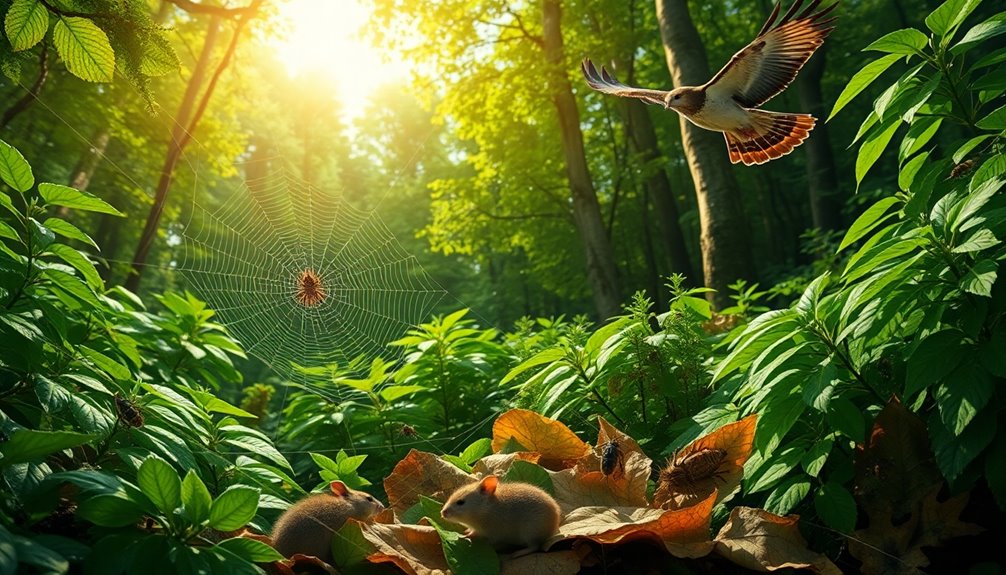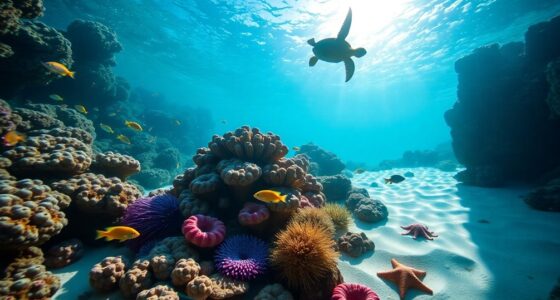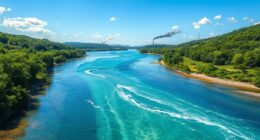Food webs typically have more biodiversity than food chains. Since food webs connect multiple species and their interactions, they create a richer network of feeding relationships. This complexity allows greater adaptability, supporting more organisms and contributing to ecosystem stability. In contrast, food chains follow a linear pattern, limiting interactions and reducing biodiversity. Because energy transfer is inefficient, a robust food web enhances resilience by recycling nutrients and maintaining ecological balance. You'll discover even more fascinating insights about the differences and their impacts as you explore further.
Key Takeaways
- Food webs contain multiple interconnected food chains, promoting higher biodiversity through diverse feeding relationships among species.
- Higher biodiversity in food webs enhances ecosystem stability and resilience against disturbances.
- Food chains represent linear energy flow with limited interactions, resulting in lower overall biodiversity.
- The complexity of food webs supports more species and interactions, contributing to ecological adaptability.
- Removal of key species in food chains can lead to overpopulation, whereas food webs maintain balance through interconnected relationships.
Arrangement and Structure
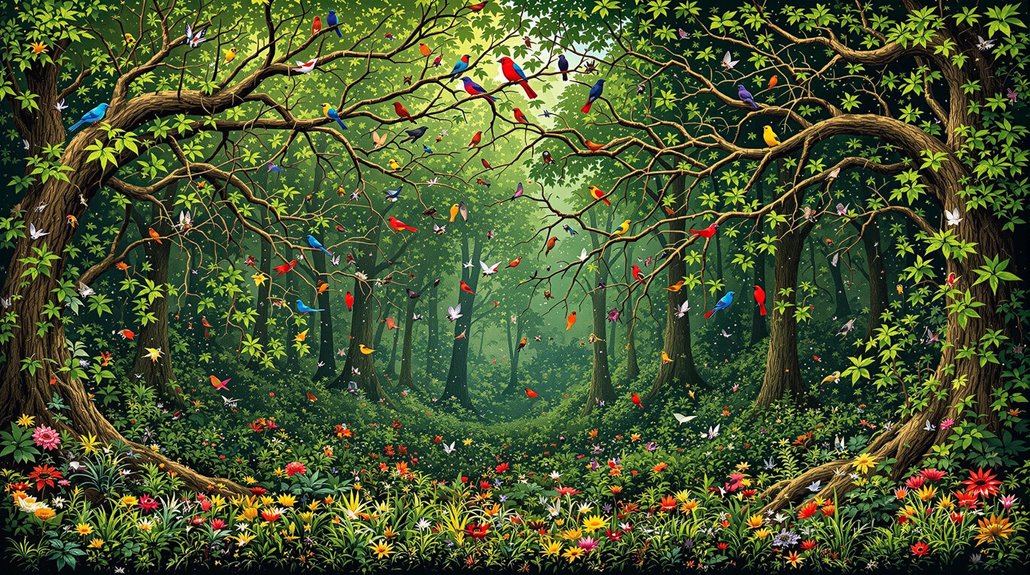
When you compare a food chain to a food web, you'll notice distinct differences in their arrangement and structure. A food chain follows a linear pattern, with energy flowing straight from one organism to the next, typically involving a single species at each trophic level. Interactions are limited to specific predator-prey relationships, creating a simple pathway of energy flow.
In contrast, a food web has a web-like pattern, showcasing multiple interconnected food chains. Each trophic level in a food web can include multiple species, leading to complex and multifaceted interactions. This structure represents various energy pathways in an ecosystem, highlighting the higher biodiversity that food webs illustrate through diverse feeding relationships among species. Additionally, food webs demonstrate greater ecosystem stability due to their interconnectedness, which helps support a diverse array of organisms.
Trophic Levels Comparison
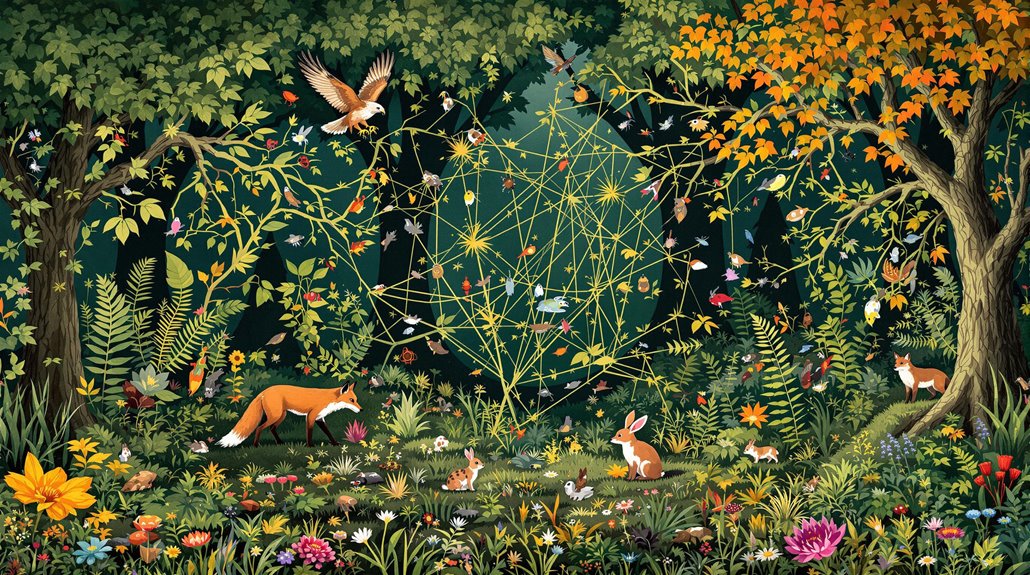
Understanding trophic levels is essential for grasping how energy flows through an ecosystem. Trophic levels classify organisms based on their feeding behavior.
At the first level, producers create their own food through photosynthesis. The second level consists of primary consumers, which eat producers. Next, secondary consumers feed on primary consumers, followed by tertiary consumers that prey on them.
Finally, apex predators sit at the top, consuming tertiary consumers. Energy transfer between these levels isn't efficient; only about 10% is passed on, leading to a decrease in biomass as you move up. This inefficiency is due to the fact that approximately 90% of energy is lost to metabolic processes or as heat.
This structure highlights the complex interactions within food webs and underscores the importance of each organism's role in maintaining ecological balance.
Biodiversity Insights

Biodiversity plays an essential role in the stability and resilience of ecosystems, as it encompasses the variety of life forms and their interactions within food webs.
In a food web, you'll find multiple interconnected food chains that represent diverse organisms across different trophic levels. This complexity reveals how species interact and compete, contributing to overall adaptability. Additionally, the removal of predators can lead to overpopulation of certain species, further emphasizing the importance of biodiversity in maintaining ecological balance. Moreover, AI-enhanced threat detection can help monitor environmental changes that affect biodiversity, ensuring timely interventions. The presence of educational toys encourages children to explore and understand the natural world, fostering an appreciation for biodiversity from an early age. Furthermore, AI security solutions can provide insights into protecting critical habitats that support diverse species. Decluttering spaces can also create healthier ecosystems by promoting mindfulness in consumption and space utilization.
With higher biodiversity, organisms have multiple food options, stabilizing the ecosystem by ensuring alternative energy sources. Decomposers recycle nutrients, maintaining life cycles.
The interconnectedness of these relationships means that the more linkages present, the greater the ecosystem's stability. This intricate web highlights the importance of each species in sustaining ecological balance and promoting a thriving environment.
Energy Flow Dynamics

The intricate relationships highlighted in food webs directly influence energy flow dynamics within ecosystems.
In a food chain, energy moves linearly from producers to consumers, with only about 10% transferring between each trophic level. The remaining energy is lost as heat or used in metabolic processes, leading to degradation.
In food webs, energy flow becomes more complex, as multiple chains interconnect and facilitate energy transfer across various trophic levels. Despite this complexity, the 10% rule still applies. Additionally, energy loss occurs due to heat, metabolism, and unconsumed matter, emphasizing the inefficiency of energy transfer.
Decomposers are essential for recycling nutrients and energy, ensuring a continuous cycle within the ecosystem.
Ecological Stability Factors

While many factors influence ecological stability, the interplay of disturbance frequency, species diversity, and ecosystem structure is essential. High-frequency disturbances, like hurricanes or human-induced changes, can weaken stability. Conversely, reduced tillage practices can enhance resilience.
Increasing species diversity through intercropping and rotations promotes a healthier ecosystem. More diverse systems can withstand pressures, like weed competition, more effectively. Species diversity enhances stability by promoting interactions among various organisms. Additionally, omega-3 fatty acids found in certain foods support cognitive function, which can be beneficial for individuals making decisions regarding ecological practices. For example, foraging for wild edibles can contribute to a diverse diet and connect individuals to their local ecosystems. Moreover, maintaining healthy beach ecosystems is crucial for preserving marine life and promoting biodiversity. Furthermore, incorporating anti-inflammatory herbs into diets can enhance overall health, supporting individuals in making sustainable ecological choices.
Ecosystem structure also matters; redundancy in populations helps maintain important functions. Complex food webs contribute to stability by ensuring efficient nutrient recycling.
However, overgrazing and climate changes can jeopardize this balance. Ultimately, an ecosystem's ability to recover, or its resilience, defines its stability. Fostering biodiversity is imperative to sustaining ecological health and longevity.
Frequently Asked Questions
How Do Human Activities Impact Food Chains and Webs?
Human activities profoundly impact food chains and webs in various ways.
When you alter habitats through deforestation or urbanization, you disrupt the balance of ecosystems. Overexploitation of species, like overfishing and hunting, decreases populations, affecting entire food chains.
Pollution from pesticides and chemicals harms plants and animals, while climate change shifts species distributions and behaviors. Each of these actions reduces biodiversity, making ecosystems less resilient and more vulnerable to further disruptions.
Can Food Webs Be Simplified Without Losing Biodiversity?
Did you know that habitat destruction is responsible for the loss of about 80% of the world's biodiversity?
You can't simplify food webs without losing biodiversity. When species disappear due to habitat loss, pollution, or climate change, the intricate connections within ecosystems weaken.
This simplification leads to less resilient systems, making them vulnerable to further environmental changes. So, every loss impacts not just individual species but the entire ecological balance.
What Role Do Apex Predators Play in Food Webs?
Apex predators play an essential role in food webs by controlling prey populations and maintaining ecosystem balance. They target the weaker individuals, promoting healthier prey populations and enhancing genetic diversity.
This regulation prevents overgrazing, allowing various species to coexist and thrive. By influencing natural selection, apex predators drive evolutionary adaptations and contribute to the complexity of ecosystems, making them more resilient and biodiverse.
Their presence guarantees that resources are utilized efficiently across the environment.
How Do Climate Changes Affect Food Web Dynamics?
Imagine a delicate dance of nature, where every step matters. Climate change disrupts this choreography, causing species to shift locations, miss their cues for breeding, and alter their diets.
You see polar bears struggling without sea ice, while birds might breed too early if their food doesn't show up on time. As the dance changes, the entire ecosystem's balance teeters, reminding us how interconnected and fragile life truly is.
Are There Specific Ecosystems With Unique Food Web Structures?
Yes, there are specific ecosystems with unique food web structures.
In terrestrial ecosystems, you see complex interactions among plants, herbivores, and predators. Aquatic ecosystems feature interconnected chains involving phytoplankton and marine animals.
Deserts have adapted food webs with organisms that conserve water. Each ecosystem's structure reflects its environment and biodiversity, showcasing how energy flows and the roles of key species, like the arctic fox or sea otter, maintain ecological balance.
Conclusion
So, while you might think food chains, with their neat hierarchies, are the pinnacle of biodiversity, it's actually the tangled chaos of food webs that reigns supreme. Who knew complexity could be so appealing? In this intricate dance of life, diverse interactions spark resilience, proving that nature thrives on messiness. So, next time you admire a simple food chain, remember: it's the web of connections, not the straight lines, that really keeps the ecosystem buzzing.
